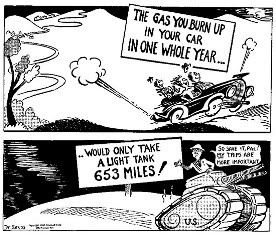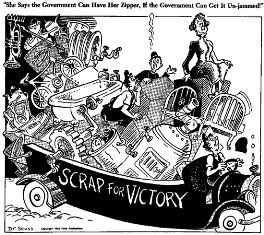Name: Kori Kivley
Date: April 7th-8th, 2008
Subject: 6th Grade Social Studies
50 minute class period
National or State Benchmarks Addressed:
Taken from the Minnesota Academic Standards in History and Social Studies:
I.I.4. Students will evaluate the impact of World War II on the home front and on American culture, including Japanese internment, Tuskegee Airmen, and “Rosie the Riveter.”
Key concepts/skills/values: rationing, saving, re-using, recycling, mathematical skills
Objectives: By the end of this lesson, students will be able to:
1. Identify what goods/services were rationed in the United States during WWII
2. Understand why the United States rationed these goods.
3. Create a ‘what if’ scenario in groups on how they would have rationed
Provisions for Individual Differences:
The first provision was made for a student with attention deficit/hyperactivity disorder. She learns well when doing hands on activities, so the rationing game was incorporated into this lesson. Her aid may also be present doing this time if need be.
The second provision was made for an ESL student. With the video I will be showing the students from You Tube, he will be able to see the material presented in different ways.
Materials:
1. Internet – Dr. Seuss Cartoons
2. Examples of products being rationed
a. Coffee
b. Sugar
c. Nylon
d. Gas
3. Photocopy of the excerpt from World War II for Kids p. 50
a. Ruth H. Statement from World War I
b. Copy of War Ration Book No. 4
4. Directions to play Rationing Game from World War II for Kids p. 53
Rationing Cartoon about gas
Rationing Cartoon about recycling scrap metal
http://orpheus.ucsd.edu/speccoll/dspolitic/Frame.htm
Sequence of Learning Activities
Anticipatory Set:
Show the students the coffee, sugar and nylons. Ask them how often they feel they use these products in every day life. List these on the board. Once you get at least 6 or 7 responses tell them that years ago, when their great grandparents were alive, these products were not available all the time. Write on the board how often a family would use these products during WWII. This should take 10 minutes.
Frame:
Give an overview of the lesson. Start off by showing the students the different cartoons from Dr. Seuss relating to rationing. Read them the excerpt from the WWII for Kids. Explain to them that manufacturers were not producing that many goods for the public, due to the war effort. Tell them that fats were especially important because this ingredient was vital when making explosives. Many of the exports had ceased as well since these cargo ships were prone to attacks from Germany and Japan. The President at the time, Franklin Delano Roosevelt, formed the Office of Price Administration (OPA). He did this to prevent some families buying so much, that it would leave other families with nothing. This led to the United States issuing rationing books to each U.S. citizen. The stamps in these ration books had pictures on them or point values. Many people decided to grow Victory Gardens – growing their own fruits and vegetables for their personal use. Introduce the rationing game to the students, and tell them this will help them gain insight now how people in the United States survived rationing during World War II. Each student should have brought 2 food items from home. This should take 10 minutes also.
The Home Front during World War 1, 1916-1918
"My father was in the Civil Defense Unit, and he patrolled the streets. My brother, 13 at the time, was a Boy Scout and he sold Liberty Bonds from a truck. My sister and I had a war garden at the Brooklyn Botanic Gardens, and we grew all kinds of vegetables. We used them for our own use and gave them to neighbors, and my mother canned a good many. And then my mother participated with a group of women who trained women to supply recipes for meatless days that were required. We had that during World War I. Sugar and meat were rationed. Children in the elementary school were taught to knit socks and scarves to send overseas to the men in the service. It was a very patriotic time for people in World War I, as you can tell by the things that we did. When we go into the war, we had to give in the support that we could. On Armistice Day, I remember that my mother was in the city [New York], and the crowds were so active and excited that she was practically carried along, off her feet, by the excitement of the end of the war."
-Ruth H., born 1902(As you can see, the same patriotism existed in both wars, and the people that experienced World War I, were ready to sacrifice again for World War II).
Procedures and Strategies:
Rationing Game:
1. Explain the rules to the class, while writing them on the board.
2. Split the students into groups of 4 or 5.
3. Write down the Rationing Chart from 1943 on the board.
4. Hand out the supplies to each group:
a. 6 or 7 rolls of pennies
b. 5 or 6 rolls of nickels
c. 2 Styrofoam cups
d. Worksheet and paper
e. Calculator
5. Give the students 15-20 minutes to play the game.
6. As a group have them answer the following questions:
a. Which items would your group NEVER buy?
b. Which items would your group ALWAYS buy?
c. How did your group do on the rationing method?
7. Give the students 10 minutes to fill out the questions on their worksheet
8. Once the students have finished their worksheets, have them return to their seats.
9. Discuss the entire class’s results and answer any questions they might have.
10. Students should hand in the worksheet to be graded.
Assessment
Objective 1 will be graded during the class discussions both before and after the lesson. It will show they are paying attention, and who has grasped the idea of which items were rationed and why. As the teacher, I will make mental note of who is struggling, and who is succeeding.
Objective 2 will be assessed during the game playing process. I will be walking around and observing the students. Students will be able to see first hand how the United States was able to ration certain goods. By listening to the class discussions, they should be able to answer the questions to go along with their game. This worksheet will be handed in for a grade.
Objective 3 will be assessed at the end of the lesson when we all come back to together as a group. We will share our results, and see how the students interpret them. Again, I will make mental notes about which students have grasped this idea and which ones are still struggling.
Wednesday, April 30, 2008
Rationing in the United States during World War II
Posted by kkiv09 at 7:48 PM
Subscribe to:
Post Comments (Atom)
1 comments:
This looks like a great activity to help kids understand rationing. Would you kindly contact me and let me know what the rules of the game are and where I can find the 1943 rationing chart?
Post a Comment